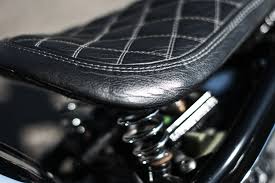Motorcycle seat upholstery is the process of covering the seat of a motorcycle with a material that enhances its comfort, durability, and aesthetic appeal. Upholstery involves a range of tasks, including removing the existing seat cover, padding the seat, cutting and shaping the new upholstery material, and attaching it to the seat. The upholstery material can be made from various materials such as leather, vinyl, and synthetic materials. The choice of material depends on the rider’s preference, the motorcycle model, and the intended use of the motorcycle. Leather is a popular choice for motorcycle seat upholstery because it is durable, comfortable, and stylish. It provides a luxurious look and feel to the seat and is resistant to wear and tear. Leather requires proper maintenance to keep it looking good and to extend its lifespan. Vinyl is another material used for motorcycle seat upholstery. It is less expensive than leather and offers similar qualities, such as durability and resistance to wear and tear. Vinyl can be customized to look like leather and is available in various colors and patterns. Vinyl requires less maintenance than leather and can be cleaned with a damp cloth and mild soap.
Synthetic materials such as neoprene and polyester are also used for motorcycle seat upholstery. These materials offer excellent protection against the elements and are resistant to water and sunlight. They are lightweight, durable, and easy to maintain. However, they may not provide the same level of comfort as leather or vinyl. When upholstering a motorcycle seat, the first step is to remove the existing seat cover. The seat is then cleaned, and any damaged padding is replaced. The new upholstery material is then cut to the desired size and shape, taking into consideration any seams and contours in the seat. The upholstery material is then attached to the seat using staples, glue, or screws, depending on the material used and the design of the seat.
The upholstery can be further customized by adding embroidery, stitching, or logos. This can be done by using a sewing machine or by hand stitching. These customizations add a personal touch to the motorcycle and make it stand out from others. Motorcycle seat upholstery is an essential aspect of motorcycle customization that plays a significant role in enhancing the comfort, style, and durability of the bike. The motorcycle seat is a critical component of the motorcycle’s design, and its upholstery is an essential part of maintaining the bike’s comfort level. This article will cover everything you need to know about motorcycle seat upholstery, including its importance, the types of materials used, and how to choose the right upholstery for your motorcycle.
Importance of Motorcycle Seat Upholstery
The motorcycle seat is an essential part of the bike’s design, providing comfort and support for the rider and passenger. The motorcycle seat’s upholstery is just as important because it can enhance the seat’s comfort, improve the bike’s appearance, and make the seat more durable. The upholstery can also protect the seat from damage caused by exposure to the elements, such as sun, rain, and wind.
Types of Materials Used for Motorcycle Seat Upholstery
Several types of materials are used for motorcycle seat upholstery. The most common materials include leather, vinyl, and synthetic materials. Each material has its advantages and disadvantages, and it is essential to consider these factors when choosing the right upholstery for your motorcycle seat.
Leather Upholstery: Leather is a classic material that has been used for motorcycle seat upholstery for decades. It is durable, comfortable, and provides a luxurious feel to the seat. Leather upholstery is also easy to maintain, and it can be cleaned with a leather cleaner and conditioner. However, leather is expensive, and it may not be suitable for all types of motorcycles.
Vinyl Upholstery: Vinyl is a synthetic material that is commonly used for motorcycle seat upholstery. It is durable, easy to clean, and less expensive than leather. Vinyl can also be customized to look like leather, making it a popular choice among motorcycle enthusiasts. However, vinyl may not be as comfortable as leather, and it may not provide the same level of luxury.
Synthetic Upholstery: Synthetic materials, such as neoprene and polyester, are also used for motorcycle seat upholstery. These materials are lightweight, durable, and provide excellent protection against the elements. They are also easy to maintain and can be cleaned with soap and water. However, synthetic materials may not provide the same level of comfort and luxury as leather or vinyl.
Choosing the Right Upholstery for Your Motorcycle Seat
When choosing the right upholstery for your motorcycle seat, there are several factors to consider, including comfort, durability, and style. It is also essential to consider your budget and the type of motorcycle you have.
Comfort: Comfort is essential when choosing upholstery for your motorcycle seat. Leather and vinyl upholstery are generally the most comfortable options, but synthetic materials can also provide comfort and support.
Durability: Durability is also an essential factor to consider. Leather upholstery is the most durable option, but vinyl and synthetic materials can also provide excellent durability.
Style: The style of your motorcycle should also be considered when choosing upholstery. Leather and vinyl upholstery can provide a classic and stylish look, while synthetic materials can provide a more modern and sporty appearance.
Budget: Finally, it is essential to consider your budget. Leather upholstery is the most expensive option, while vinyl and synthetic materials are generally less expensive. In conclusion, motorcycle seat upholstery is an essential aspect of motorcycle customization that can enhance the comfort, style, and durability of your bike. Leather, vinyl, and synthetic materials are commonly used for motorcycle seat upholstery, and each material has its advantages and disadvantages. When choosing the right upholstery for your motorcycle seat, it is essential to consider comfort, durability, style, and budget.

